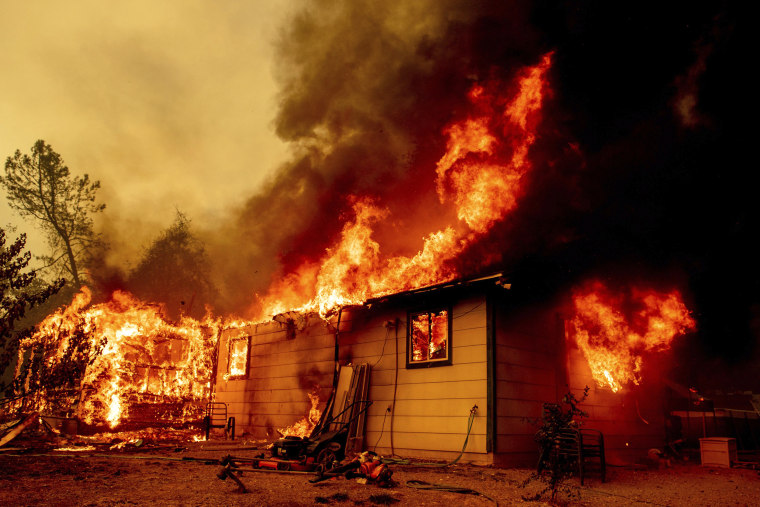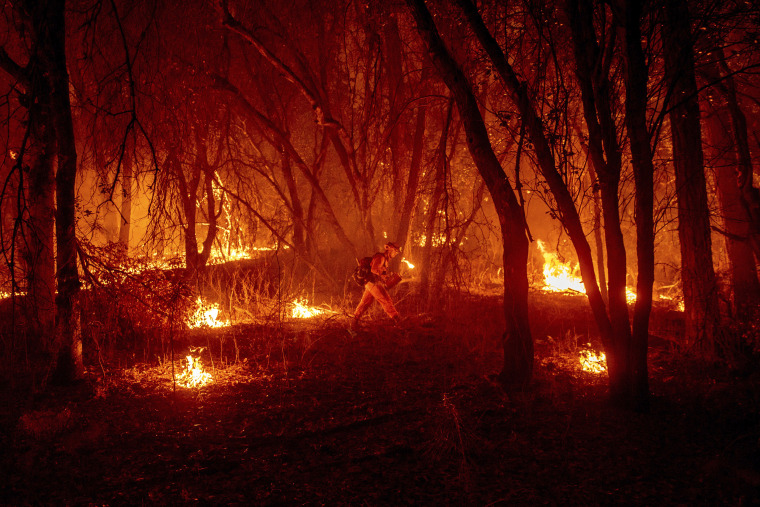Authorities in Northern California last week announced the arrest of a woman who they say ignited a wind-whipped wildfire that quickly tore through steep, rugged terrain, destroying 144 buildings, prompting the evacuation of thousands of people and becoming one of the state's more destructive blazes this year.
The woman, Alexandra Souverneva, 30, a onetime yoga teacher from the San Francisco Bay Area whom a former colleague recalled as "brilliant," is among more than 100 people who have been accused of wildland arson and arrested this year by the California Department of Forestry and Fire Protection, or Cal Fire.
The charge alleges a rare but significant act that has come into sharper focus as parched, overgrown forests explode across thousands of acres in days.
"It is difficult to grasp when disaster like this is, apparently, not a natural disaster, but we have a suspect, and this might be an arson case," Shasta County Sheriff Michael Johnson said during a community meeting Saturday.
Souverneva has pleaded not guilty.

Wildfires are usually accidental, ignited by damaged power lines, vehicles and logging equipment, said Ed Nordskog, a retired arson investigator with the Los Angeles County Sheriff's Department and a co-author of "Arson Investigation in the Wildlands."
While most wildfire agencies attribute about 10 percent of blazes to arson, Nordskog said the real number could be twice as high — a result of decades of officials' prioritizing suppression over investigations.
"If you don't send an investigator, you don't have arson," he said.
The intentional setting of a wildland fire can have swift, profound consequences. As Nordskog put it: "They literally have the power of an atomic bomb at their fingertips. They can burn an entire town down if the conditions are right."
In 2006, for instance, a wind-driven blaze burned across 40,000 acres in Southern California, destroying dozens of homes and killing five firefighters. Raymond Oyler, a mechanic from Riverside County, was convicted of arson and murder and sentenced to death.
In 2008, a former volunteer firefighter from Northern California, Robert Eason, was convicted of setting a dozen fires north of Sacramento, including one that burned 1,000 acres and killed 200 sheep. Investigators said Eason used a sophisticated time-delay device to ignite the fires.
Unlike urban arsonists, whose ages, genders and races vary, wildland arsonists tend to be middle-age men, said Nordskog, who also wrote "The Arsonist Profiles: Analyzing Arson Motives and Behavior." Although lighters and matches are the preferred methods of ignition, some people, like Eason, use time-delay devices, such as matches wrapped around a cigarette, he said.
"When they burst into flames, they're seven to 15 miles away," Nordskog said.
Although some arsonists act for thrills, Nordskog said, anger, frustration and mental illness are more common motives. Just as common is how daunting the investigations can be. They're often in remote areas, with ignition points that could be devastated as firefighters work to extinguish the blazes, he said.
Fire officials said Souverneva was arrested Wednesday night after she emerged from the brush near a fire line northeast of Redding in Shasta County. She had a working lighter in her pocket, Shasta County District Attorney Stephanie Bridgett said Friday, and told firefighters that she was dehydrated and needed medical treatment.
According to a Cal Fire report obtained by the Record Searchlight of Redding, Souverneva said she was hiking to Canada and tried to boil water that she found in a puddle. Her attempts failed, the report said, but she drank the water anyway — she believed it was mixed with bear urine — then walked uphill and saw smoke and airplanes “dropping pink stuff.”
Souverneva was taken into custody on suspicion of arson.
Because of a declared state of emergency, Souverneva faces an enhanced sentence of nine years if she is convicted, Bridgett said. She said authorities are "aware" of other fires locally and around the state that Souverneva "may be linked to." Bridgett declined to provide additional details.
Bridgett, who also declined to discuss a possible motive, said there was no indication that Souverneva was under the influence of drugs or alcohol. Nor did she appear mentally ill, Bridgett said, although witnesses who saw her earlier said she was acting "irrationally," Cal Fire said in a statement.
Souverneva pleaded not guilty to felony arson. Her attorney, Shana Vegvary, said that Souverneva was "asserting her innocence" and that "no evidence has been presented to the contrary."
"We request that the public not prejudge this case," she said.
Relatives in the Bay Area did not respond to requests for comment. A former colleague and instructor who taught Souverneva at Avalon Yoga International, in Palo Alto, recalled her as a brilliant student who attended the California Institute of Technology and worked for pharmaceutical companies before she burned out on "big money-grubbing corporations."
"I thought she was an idealistic kid," said Steve Farmer, the chief executive of Avalon. "She was into conservation and forests."
Farmer said he hadn't seen her since the pandemic started, when Avalon closed, although he planned to rehire her after it reopened. "She would have been the last person I would have thought to get involved in something like this," he said.
As of Monday, the fire in Shasta County had destroyed dozens of homes and grown to nearly 9,000 acres, according to Cal Fire. Firefighters had surrounded half of the blaze with containment lines.
